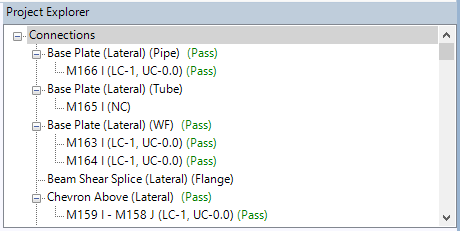
RISAConnection has the ability to integrate with RISAFloor and RISA-3D. The integration involves importing all geometry, member sizes, design specifications, and loading into RISAConnection seamlessly from RISAFloor and/or RISA-3D. To learn how to take the model into RISAConnection, view the RISAConnection Integration topic within the RISAFloor or RISA-3D help file. This portion of the help file will explain how everything works on the RISAConnection side.
When first coming into RISAConnection from RISAFloor or RISA-3D you will see that the file is populated with all of the VALID connections. Thus, only connections that RISAConnection can actually design will be brought over. Exporting to RISAConnection from RISAFloor or RISA-3D will create a RISAConnection file (with a .rcn extension) that will have the same name as the RISAFloor or RISA-3D model and will be located in the same directory.
Notes:
Once you have imported your information in RISAConnection, you will see that the connections are grouped in the Project Explorer.

The groups in RISAConnection are based on the Connection Rules from RISAFloor and RISA-3D. Within each Connection Rule, however, there are also groupings based on whether the members are lateral vs gravity and whether a column/beam connection frames into the web or flange of the column. Therefore, a single connection rule could potentially create as many as four groupings in RISAConnection.
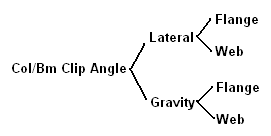
A Lateral member is a member that has been defined in RISAFloor as Lateral, or is a 3D-only member.
A Gravity member is a member defined in RISAFloor as Gravity.
The grouping is also dependent on the Shape Type used in the connection. Here is a breakdown:
Note:
In the Project Explorer there are three levels: Project level, Group level, and Connection level. These levels are nested within each other and allow you to change design and connection properties quickly and easily. There are also properties that can only be changed within RISAFloor or RISA-3D. Here we will discuss these different connection property categories and how to use them properly.
Items that can only be modified from RISAFloor or RISA-3D
If you wish to modify any of these properties you need to go back to the RISAFloor or RISA-3D model, make the change, and then re-export to RISAConnection.
When you click the project label in the Project Explorer, the Project Properties are then shown.
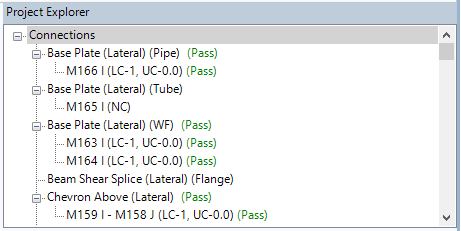
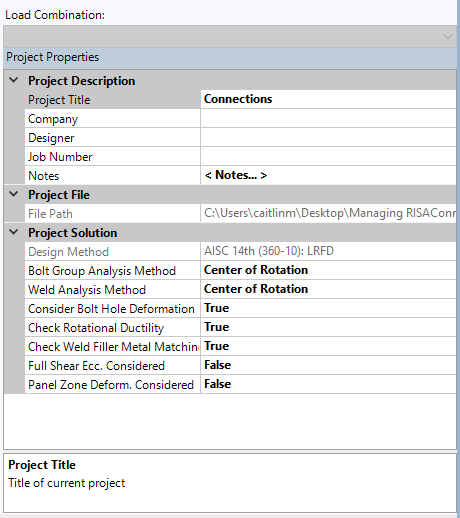
Here you can update information in the Project Description fields and some of the options from the Global Settings - Solution tab.
Note:
When you click on a Group in the Project Explorer then the Group Properties are shown.
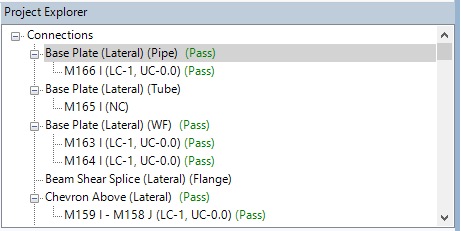
In the Group Properties you can modify connection properties for all of the connections within this group at one time. The grayed out properties are properties brought over directly from RISAFloor and RISA-3D; these properties can not be edited in RISAConnection.
If an item is labeled -Various- it means that there are multiple values in this field for the different connections in this group.
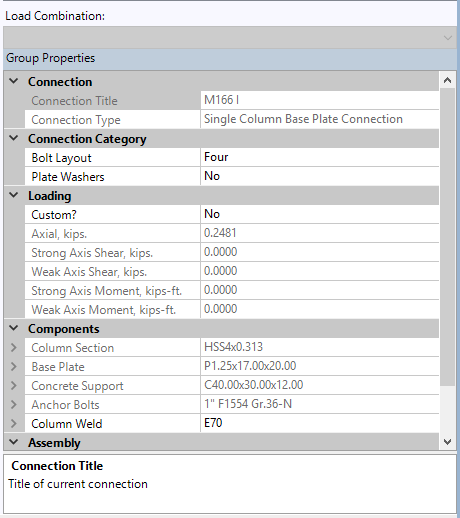
Note:
When you click on an individual connection, that connection's properties are shown.
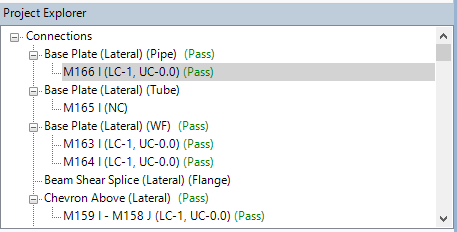
The grayed out properties within an individual connection may be either RISAFloor/3D controlled, Project level controlled, or Group level controlled. You must go up to those levels to change these properties for these connections.
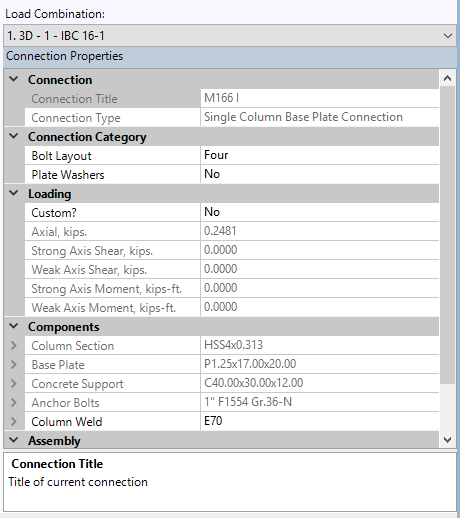
All load combinations from RISAFloor and RISA-3D that have the Connection check-box selected in the Load Combinations spreadsheet will be brought into RISAConnection. There is a Load Combination drop-down in the upper-right hand corner. This drop down is only available when looking at an individual connection. You can scroll through the load combinations and viewing the loading and results for each. The load combinations are renumbered because it is possible to bring load combinations from both RISAFloor and RISA-3D into RISAConnection. Since we are potentially combining two sets of load combinations, RISAConnection must renumber them for clarity. The program is listed in front of the load combination in the RISAConnection menu as show below ("3D" means that the combinations came from your RISA-3D model).

When you are viewing a specific load combination then you can see the forces for the connection in the Loading section. For moment connections you can also see the Top Column Dist, Column Force and Story Shear values that are brought over from the RISAFloor or RISA-3D model as well. By default, these forces are only available for viewing.
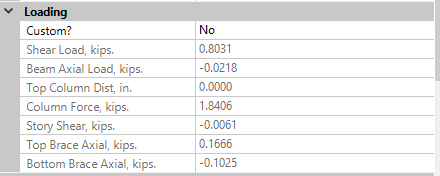
But if you set the Custom Loading flag to "Yes" then you can edit the loads to whatever you want. Just note that this no longer corresponds to the RISA-3D/RISAFloor loading.
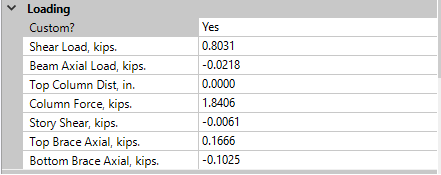
Note:
Once you get the connections configured properly you need to solve the model. You can solve the model by connection, by group or for the entire project. Every load combination from RISAFloor and RISA-3D will be solved each time.
There are two ways to access solving options:


Note:
Once you have a connection, a group, or the entire project solved you will be able to view results via the Project Explorer or Reports tab.
The Project Explorer gives a summary of the design results for the project. Each connection gives a Pass or Fail notification, along with the Max UC and the LC that produced it.
The Group will state "Pass" if all of the connections within the group passes. It will state "Fail" otherwise.
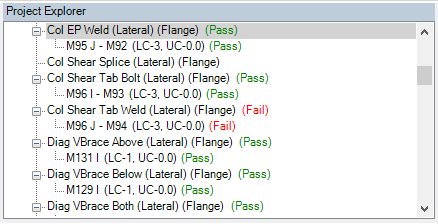
If a property is changed then the connections whose properties are affected will be invalidated. If you modify a single connection then the results for that connection will be invalidated and an (N/A) will be shown.
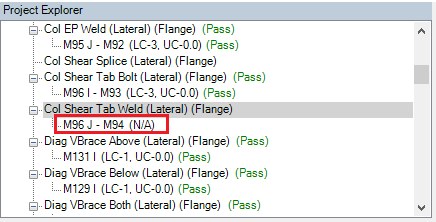
In this scenario you can simply re-solve that connection to get results again.
If you invalidate a group property then that will invalidate all of the connections within that group. If you invalidate a project property, then it will invalidate all connections in the project.
The Report view gives the unity checks for the load combination shown in the Load Combination dropdown. The load combination selected by default is the one that produced the worst case unity check value. The Reports section will show which Limit State produced this value.

If the connection you are viewing has its results invalidated by changing a connection property, then this message will be shown:

If this message is shown then the results shown are invalid. Pressing this message has the effect of solving that individual connection for all load combinations. The program will then give valid results for this connection.
Once you have your connections configured properly you can take those results back to RISAFloor and RISA-3D to be viewed in the Connection Results browser and graphically. To do this you must have the RISAFloor or RISA-3D model opened and solved.
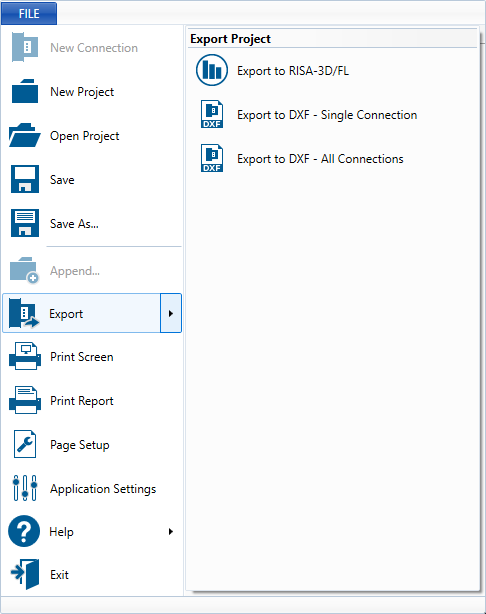

The RISAFloor/RISA-3D and RISAConnection integration is meant to be used for multiple round-trips. Items to note with this integration:
When a RISAConnection model is created by exporting from RISA-3D, RISAFloor, or Revit, many of the input options are grayed out. These are the parameters that are defined in the original program (RISA-3D, RISAFloor, or Revit). To release the integrated ownership of the RISAConnection model, you can detach the RISAConnection file. This releases the ownership so you have control to change all input parameters in RISAConnection.
If you want to detach the RISAConnection file, simply click on the Detach button once in RISAConnection. The program will give you a warning and then, if you click Yes, detach and rename the file.

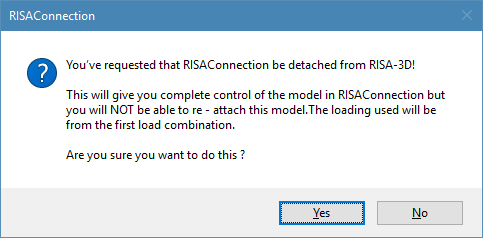
Note:
When connections are transferred from RISAFloor to RISAConnection, live load reduction is accounted for in the reactions that are transferred.